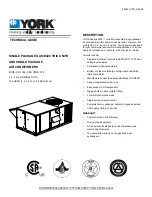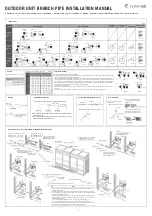
29
GB
Satisfy the minimum insertion depth in the table below when expanding field-
supplied piping
Pipe diameter
(mm [in])
Minimum insertion depth
(mm [in])
5 [7/32] or more, less than 8 [11/32]
6 [1/4]
8 [11/32] or more, less than 12 [1/2]
7 [9/32]
12 [1/2] or more, less than 16 [21/32]
8 [11/32]
16 [21/32] or more, less than 25 [1]
10 [13/32]
25 [1] or more, less than 35 [1-13/32]
12 [1/2]
35 [1-13/32] or more, less than 45 [1-25/32]
14 [9/16]
•
After evacuation and refrigerant charging, ensure that the handle is fully
open. If keep the valve closed, the high- or low-pressure side of the
refrigerant circuit may be subjected to abnormal pressure and may damage
the compressor, four-way valve, etc.
•
Determine the amount of additional refrigerant charge by using the formula,
and charge refrigerant through the service port after connecting the pipes.
•
Tighten the service port and cap securely so gas does not leak. (Refer to the
table below for appropriate tightening torque.)
Appropriate tightening torque:
Outside
diameter of
copper pipe
(mm [in])
Cap
(N·m/kg·cm)
Shaft
(N·m/kg·cm)
Size of
hexagonal
wrench
(mm)
Service port
(N·m/kg·cm)
ø9.52 [3/8]
15/150
6/60
4
12/120
ø12.7 [1/2]
20/200
9/90
4
ø15.88 [5/8]
25/250
15/150
6
ø19.05 [3/4]
25/250
30/300
8
ø25.4 [1]
25/250
30/300
8
Caution:
• Keep the valve closed until the refrigerant charging is finished.
Opening the valve before charging the refrigerant may cause damage
to the unit.
•
Do not use a leak detection additive.
10.3. Airtight test, evacuation, and
refrigerant charging
1
Airtight test
Perform with the valve of the heat source unit closed, charging the
refrigerant pressurize the connection piping and the indoor unit from the
service port provided on the valve of the heat source unit. (Always pressurize
from both the high-pressure/gas pipe and the low-pressure/liquid pipe
service ports.)
[Fig. 10.3.1] (P.12)
A
Nitrogen gas
B
To indoor unit
C
System analyzer
D
Low knob
E
High knob
F
Valve
G
Low-pressure/liquid pipe
H
High-pressure/gas pipe
I
Heat source unit
J
Service port
Observe the following restrictions when conducting the air tightness test
to prevent negative effects on the refrigerating machine oil. Also, with
nonazeotropic refrigerant (R410A), gas leakage causes the refrigerant
composition to change and affects performance. Therefore, conduct the
airtightness test cautiously.
Caution:
Only use R410A refrigerant.
- Using other refrigerants such as R22 or R407C, which contains chlorine,
will deteriorate the refrigerating machine oil or cause the compressor to
malfunction.
2
Evacuation
Evacuate with the valve of the heat source unit closed and evacuate both the
connection piping and the indoor unit from the service port provided on the
valve of the heat source unit using a vacuum pump. (Always evacuate from
the service port of both the high-pressure/gas pipe and the low-pressure/
liquid pipe.) After the vacuum reaches 650 Pa [abs] [0.0943 psi/5 Torr],
evacuate for at least one hour or more. Then, stop the vacuum pump and
leave it for 1 hour. Ensure the degree of vacuum has not increased.
(If the
degree of vacuum increase is larger than 130 Pa [0.01886 psi/1.0 Torr],
water might present. Apply pressure to dry nitrogen gas up to 0.05
MPa [7.25 psi] and vacuum again. Repeat the evacuation process three
or more times until the vacuum pressure is lost by 130 Pa or below.)
Finally, seal in with the liquid refrigerant through the high-pressure/gas pipe,
and adjust the low-pressure/liquid piping to obtain an appropriate amount of
the refrigerant for operation.
* Never perform air purging with refrigerant.
[Fig. 10.3.2] (P.12)
A
System analyzer
B
Low knob
C
High knob
D
Valve (heat source
unit)
E
Low-pressure/liquid
pipe
F
High-pressure/gas
pipe
G
Service port
H
Three-way joint
I
Valve
J
Valve
K
R410A cylinder
L
Scale
M
Vacuum pump
N
To indoor unit
O
Heat source unit
Note:
•
Always add the appropriate amount of refrigerant. Also always charge
the system with liquid refrigerant.
•
Use a gauge manifold, charging hose, and other parts for the
refrigerant indicated on the unit.
•
Use a graviometer. (One that can measure down to 0.1 kg [302 oz].)
• Use a vacuum pump with a reverse flow check valve.
(Recommended vacuum gauge: ROBINAIR 14830A Thermistor Vacuum
Gauge or Micron Gauge)
Do not use a manifold gauge to measure vacuum pressure.
Also use a vacuum gauge that reaches 65 Pa [abs] [0.00943 psi/0.5
Torr] or below after operating for five minutes.
<Triple Evacuation>
•
Evacuate the system to 4,000 microns from both service valves.
System manifold gauges must not be used to measure vacuum.
A micron gauge must be used at all times.
- Break the vacuum with Nitrogen (N2) into the discharge service valve to 0
PSIG.
•
Evacuate the system to 1,500 microns from the suction service valve.
- Break the vacuum with Nitrogen (N2) into the discharge service valve to 0
PSIG.
•
Evacuate the system to 500 microns. System must hold the vacuum at
500 microns for a minimum of 1 hour.
•
Conduct a rise test for a minimum of 30 minutes.
3
Refrigerant Charging
Do not use refrigerant other than the type indicated in the manuals
provided with the unit and on the nameplate.
- Doing so may cause the unit or pipes to burst, or result in explosion or fire
during use, during repair, or at the time of disposal of the unit.
- It may also be in violation of applicable laws.
- MITSUBISHI ELECTRIC CORPORATION cannot be held responsible
for malfunctions or accidents resulting from the use of the wrong type of
refrigerant.
Airtight test procedure
Restriction
(1) After obtaining to the design pressure (4.15 MPa [602 psi]) using nitrogen gas, allow
the system to stand for about one day. If the pressure does not drop, airtightness is
good.
However, if the pressure drops, and the leakage area is unknown, the following bubble
test may also be performed.
(2) After the pressurization described above, spray the flare connection parts, brazed
parts, and other potential leakage areas with a bubbling agent (Kyuboflex, etc.) and
visually check for bubbles.
(3) After the airtight test, wipe off the bubbling agent.
• If a flammable gas or air (oxygen) is used as the pressurization
gas, it may catch fire or explode.
Summary of Contents for CITY MULTI PQHY-P YLM-A Series
Page 378: ......
















































